2004 FORD MUSTANG trailer
[x] Cancel search: trailerPage 2 of 240
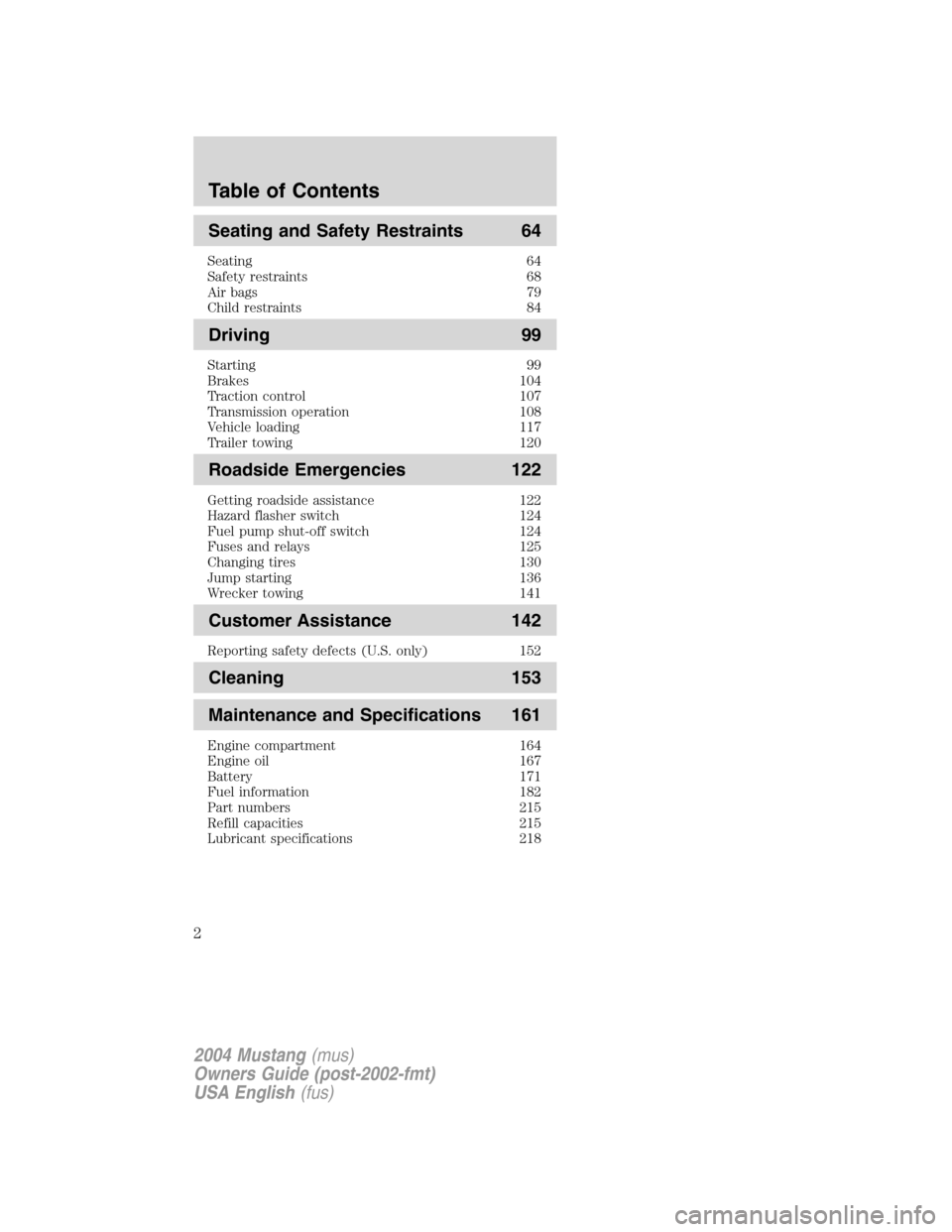
Seating and Safety Restraints 64
Seating 64
Safety restraints 68
Air bags 79
Child restraints 84
Driving 99
Starting 99
Brakes 104
Traction control 107
Transmission operation 108
Vehicle loading 117
Trailer towing 120
Roadside Emergencies 122
Getting roadside assistance 122
Hazard flasher switch 124
Fuel pump shut-off switch 124
Fuses and relays 125
Changing tires 130
Jump starting 136
Wrecker towing 141
Customer Assistance 142
Reporting safety defects (U.S. only) 152
Cleaning 153
Maintenance and Specifications 161
Engine compartment 164
Engine oil 167
Battery 171
Fuel information 182
Part numbers 215
Refill capacities 215
Lubricant specifications 218
2004 Mustang(mus)
Owners Guide (post-2002-fmt)
USA English(fus)
Table of Contents
2
Page 113 of 240
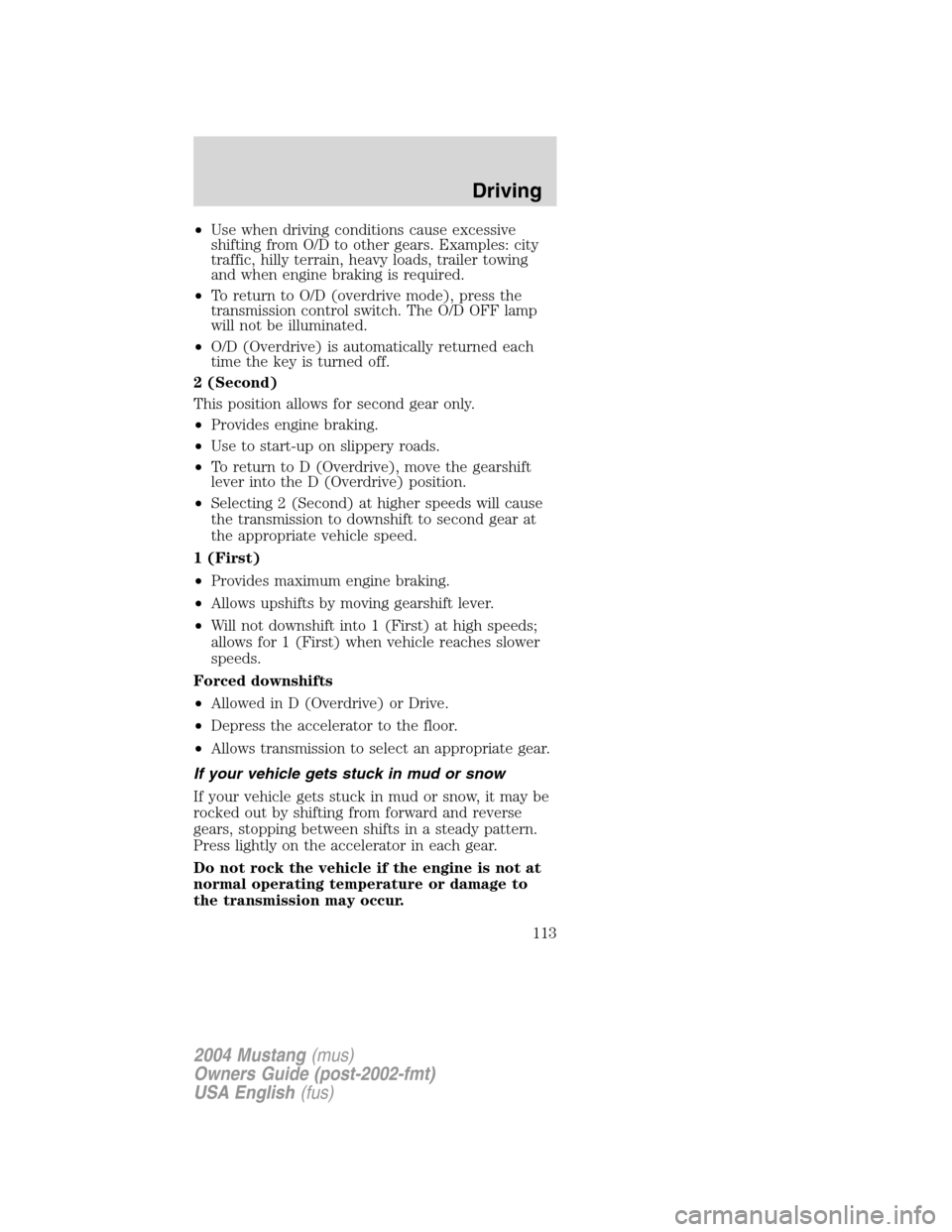
•Use when driving conditions cause excessive
shifting from O/D to other gears. Examples: city
traffic, hilly terrain, heavy loads, trailer towing
and when engine braking is required.
•To return to O/D (overdrive mode), press the
transmission control switch. The O/D OFF lamp
will not be illuminated.
•O/D (Overdrive) is automatically returned each
time the key is turned off.
2 (Second)
This position allows for second gear only.
•Provides engine braking.
•Use to start-up on slippery roads.
•To return to D (Overdrive), move the gearshift
lever into the D (Overdrive) position.
•Selecting 2 (Second) at higher speeds will cause
the transmission to downshift to second gear at
the appropriate vehicle speed.
1 (First)
•Provides maximum engine braking.
•Allows upshifts by moving gearshift lever.
•Will not downshift into 1 (First) at high speeds;
allows for 1 (First) when vehicle reaches slower
speeds.
Forced downshifts
•Allowed in D (Overdrive) or Drive.
•Depress the accelerator to the floor.
•Allows transmission to select an appropriate gear.
If your vehicle gets stuck in mud or snow
If your vehicle gets stuck in mud or snow, it may be
rocked out by shifting from forward and reverse
gears, stopping between shifts in a steady pattern.
Press lightly on the accelerator in each gear.
Do not rock the vehicle if the engine is not at
normal operating temperature or damage to
the transmission may occur.
2004 Mustang(mus)
Owners Guide (post-2002-fmt)
USA English(fus)
Driving
113
Page 117 of 240
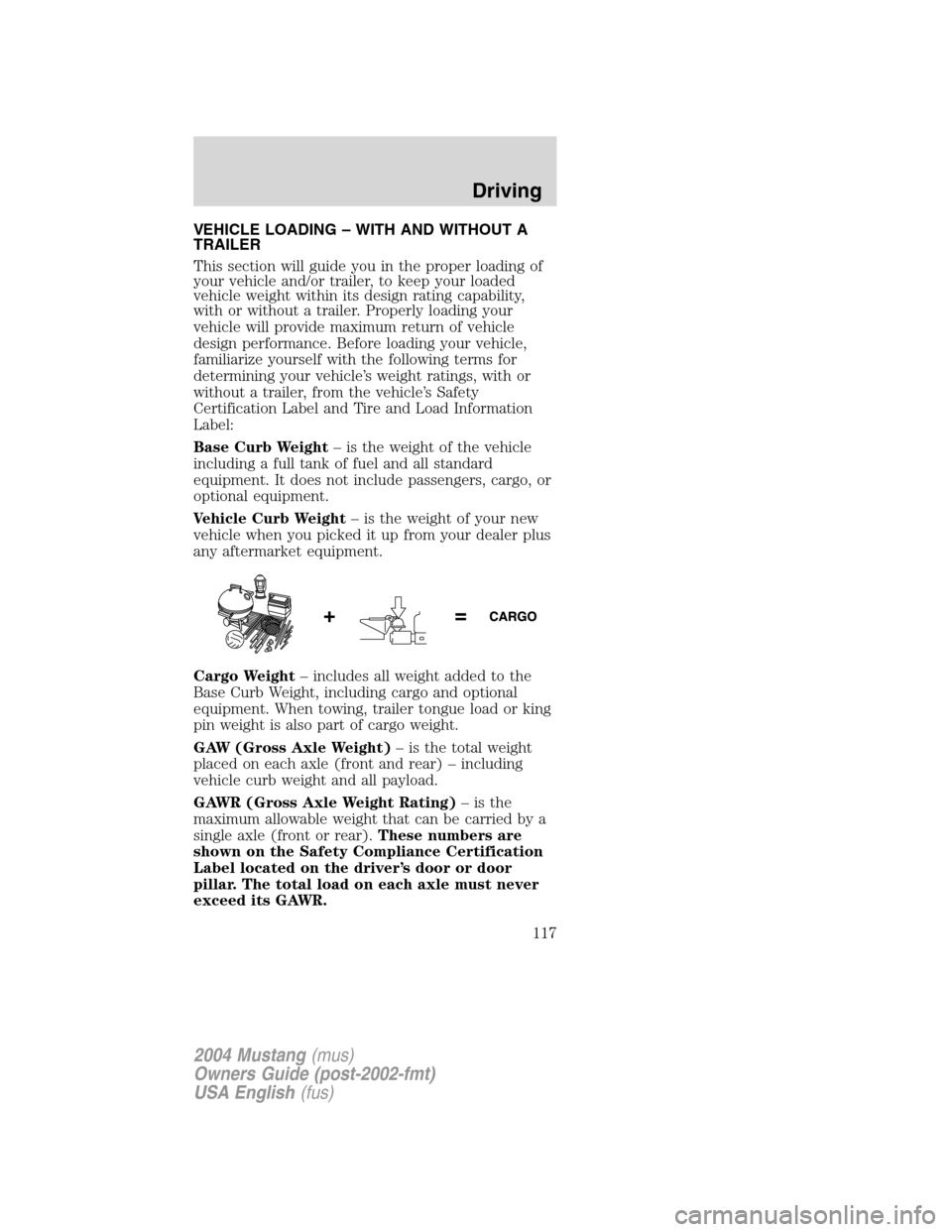
VEHICLE LOADING–WITH AND WITHOUT A
TRAILER
This section will guide you in the proper loading of
your vehicle and/or trailer, to keep your loaded
vehicle weight within its design rating capability,
with or without a trailer. Properly loading your
vehicle will provide maximum return of vehicle
design performance. Before loading your vehicle,
familiarize yourself with the following terms for
determining your vehicle’s weight ratings, with or
without a trailer, from the vehicle’s Safety
Certification Label and Tire and Load Information
Label:
Base Curb Weight–is the weight of the vehicle
including a full tank of fuel and all standard
equipment. It does not include passengers, cargo, or
optional equipment.
Vehicle Curb Weight–is the weight of your new
vehicle when you picked it up from your dealer plus
any aftermarket equipment.
Cargo Weight–includes all weight added to the
Base Curb Weight, including cargo and optional
equipment. When towing, trailer tongue load or king
pin weight is also part of cargo weight.
GAW (Gross Axle Weight)–is the total weight
placed on each axle (front and rear)–including
vehicle curb weight and all payload.
GAWR (Gross Axle Weight Rating)–is the
maximum allowable weight that can be carried by a
single axle (front or rear).These numbers are
shown on the Safety Compliance Certification
Label located on the driver’s door or door
pillar. The total load on each axle must never
exceed its GAWR.
2004 Mustang(mus)
Owners Guide (post-2002-fmt)
USA English(fus)
Driving
117
Page 118 of 240

Exceeding the Safety Certification Label
axle weight rating limits could result in
substandard vehicle handling, performance, engine,
transmission and/or structural damage, serious
damage to the vehicle, loss of control and personal
injury.
Note:For trailer towing information refer toTrailer
Towingfound in this chapter or the RV and Trailer
Towing Guide provided by your dealership.
GVW (Gross Vehicle Weight)–is the Vehicle Curb
Weight + cargo + passengers.
GVWR (Gross Vehicle
Weight Rating)–is
the maximum allowable
weight of the fully
loaded vehicle
(including all options,
equipment, passengers
and cargo).The
GVWR is shown on
the Safety
Compliance
Certification Label
located on the
driver’s door or door pillar. The GVW must
never exceed the GVWR.
Exceeding the Safety Certification Label
axle weight rating limits could result in
substandard vehicle handling, performance, engine,
transmission and/or structural damage, serious
damage to the vehicle, loss of control and personal
injury.
2004 Mustang(mus)
Owners Guide (post-2002-fmt)
USA English(fus)
Driving
118
Page 119 of 240

GCW (Gross Combined Weight)–is the weight
of the loaded vehicle (GVW) plus the weight of the
fully loaded trailer.
GCWR (Gross Combined Weight Rating)–is the
maximum allowable weight of the vehicle and the
loaded trailer–including all cargo and passengers–
that the vehicle can handle without risking damage.
(Important: The towing vehicle’s braking system is
rated for operation at GVWR, not at GCWR. Separate
functional brakes should be used for safe control of
towed vehicles and for trailers weighing more than
680 kg [1,500 lbs]).The GCW must never exceed
the GCWR.
Maximum Loaded Trailer Weight–is the highest
possible weight of a fully loaded trailer the vehicle
can tow. It assumes a vehicle with only mandatory
options, no cargo (internal or external), a tongue
load of 10–15% (conventional trailer) or king pin
weight of 15–25% (fifth wheel trailer), and driver
only (68 kg [150 lbs]).Consult your dealership
(or the RV and Trailer Towing Guide provided
by your dealership) for more detailed
information.
Tongue Load or Fifth Wheel King Pin Weight–
refers to the amount of the weight that a trailer
pushes down on a trailer hitch.
Examples:For a 2268 kg (5000 lbs.) conventional
trailer, multiply 5000 by 0.10 and 0.15 to obtain a
proper tongue load range of 227 to 340 kg (500 to
750 lbs.). For an 5216 kg (11,500 lbs.) fifth wheel
trailer, multiply by 0.15 and 0.25 to obtain a proper
king pin load range of 782 to 1304 kg (1,725 to
2,875 lbs.)
Do not exceed the GVWR or the GAWR
specified on the certification label.
2004 Mustang(mus)
Owners Guide (post-2002-fmt)
USA English(fus)
Driving
119
Page 120 of 240
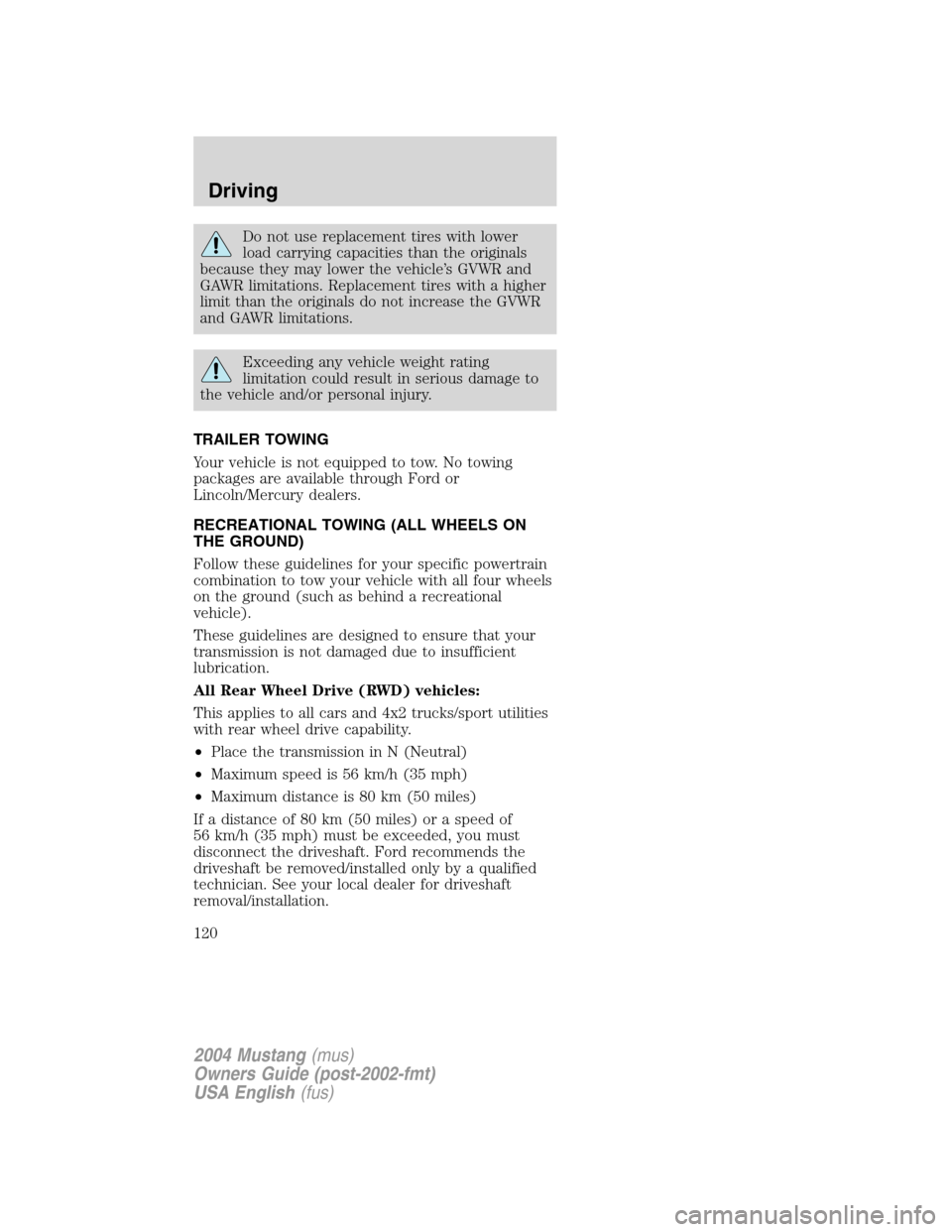
Do not use replacement tires with lower
load carrying capacities than the originals
because they may lower the vehicle’s GVWR and
GAWR limitations. Replacement tires with a higher
limit than the originals do not increase the GVWR
and GAWR limitations.
Exceeding any vehicle weight rating
limitation could result in serious damage to
the vehicle and/or personal injury.
TRAILER TOWING
Your vehicle is not equipped to tow. No towing
packages are available through Ford or
Lincoln/Mercury dealers.
RECREATIONAL TOWING (ALL WHEELS ON
THE GROUND)
Follow these guidelines for your specific powertrain
combination to tow your vehicle with all four wheels
on the ground (such as behind a recreational
vehicle).
These guidelines are designed to ensure that your
transmission is not damaged due to insufficient
lubrication.
All Rear Wheel Drive (RWD) vehicles:
This applies to all cars and 4x2 trucks/sport utilities
with rear wheel drive capability.
•Place the transmission in N (Neutral)
•Maximum speed is 56 km/h (35 mph)
•Maximum distance is 80 km (50 miles)
If a distance of 80 km (50 miles) or a speed of
56 km/h (35 mph) must be exceeded, you must
disconnect the driveshaft. Ford recommends the
driveshaft be removed/installed only by a qualified
technician. See your local dealer for driveshaft
removal/installation.
2004 Mustang(mus)
Owners Guide (post-2002-fmt)
USA English(fus)
Driving
120
Page 131 of 240
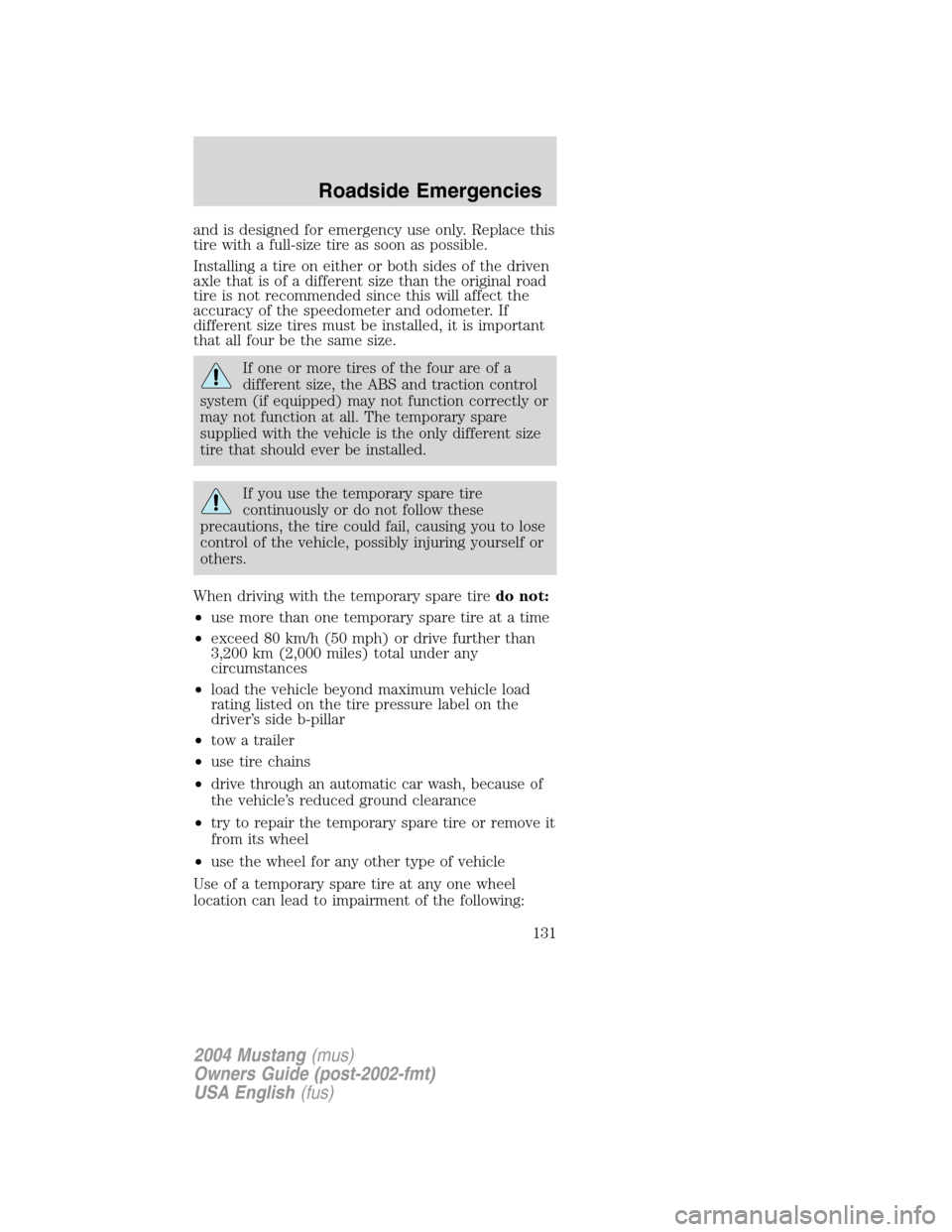
and is designed for emergency use only. Replace this
tire with a full-size tire as soon as possible.
Installing a tire on either or both sides of the driven
axle that is of a different size than the original road
tire is not recommended since this will affect the
accuracy of the speedometer and odometer. If
different size tires must be installed, it is important
that all four be the same size.
If one or more tires of the four are of a
different size, the ABS and traction control
system (if equipped) may not function correctly or
may not function at all. The temporary spare
supplied with the vehicle is the only different size
tire that should ever be installed.
If you use the temporary spare tire
continuously or do not follow these
precautions, the tire could fail, causing you to lose
control of the vehicle, possibly injuring yourself or
others.
When driving with the temporary spare tire do not:
• use more than one temporary spare tire at a time
• exceed 80 km/h (50 mph) or drive further than
3,200 km (2,000 miles) total under any
circumstances
• load the vehicle beyond maximum vehicle load
rating listed on the tire pressure label on the
driver’s side b-pillar
• tow a trailer
• use tire chains
• drive through an automatic car wash, because of
the vehicle’s reduced ground clearance
• try to repair the temporary spare tire or remove it
from its wheel
• use the wheel for any other type of vehicle
Use of a temporary spare tire at any one wheel
location can lead to impairment of the following:
2004 Mustang (mus)
Owners Guide (post-2002-fmt)
USA English (fus)
Roadside Emergencies
131
Page 190 of 240
![FORD MUSTANG 2004 4.G Owners Manual •Sudden or hard accelerations may reduce fuel
economy.
•Slow down gradually.
•Driving at reasonable speeds (traveling at 88 km/h
[55 mph] uses 15% less fuel than traveling at
105 km/h [65 mph]). FORD MUSTANG 2004 4.G Owners Manual •Sudden or hard accelerations may reduce fuel
economy.
•Slow down gradually.
•Driving at reasonable speeds (traveling at 88 km/h
[55 mph] uses 15% less fuel than traveling at
105 km/h [65 mph]).](/manual-img/11/5213/w960_5213-189.png)
•Sudden or hard accelerations may reduce fuel
economy.
•Slow down gradually.
•Driving at reasonable speeds (traveling at 88 km/h
[55 mph] uses 15% less fuel than traveling at
105 km/h [65 mph]).
•Revving the engine before turning it off may
reduce fuel economy.
•Using the air conditioner or defroster may reduce
fuel economy.
•You may want to turn off the speed control in
hilly terrain if unnecessary shifting between third
and fourth gear occurs. Unnecessary shifting of
this type could result in reduced fuel economy.
•Warming up a vehicle on cold mornings is not
required and may reduce fuel economy.
•Resting your foot on the brake pedal while driving
may reduce fuel economy.
•Combine errands and minimize stop-and-go
driving.
Maintenance
•Keep tires properly inflated and use only
recommended size.
•Operating a vehicle with the wheels out of
alignment will reduce fuel economy.
•Use recommended engine oil. Refer toLubricant
specificationsin this chapter.
•Perform all regularly scheduled maintenance
items. Follow the recommended maintenance
schedule and owner maintenance checks found in
your vehicle scheduled maintenance guide.
Conditions
•Heavily loading a vehicle or towing a trailer may
reduce fuel economy at any speed.
•Carrying unnecessary weight may reduce fuel
economy (approximately 0.4 km/L [1 mpg] is lost
for every 180 kg [400 lb] of weight carried).
2004 Mustang(mus)
Owners Guide (post-2002-fmt)
USA English(fus)
Maintenance and Specifications
190